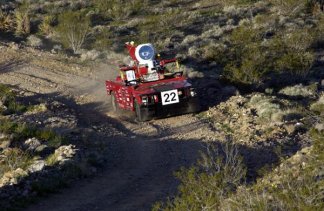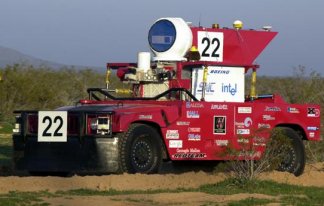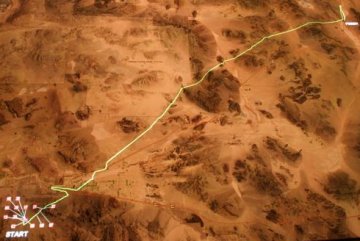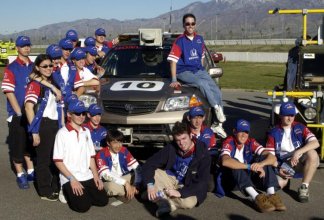Robots on a Rocky Road
In a recent race, high-tech, robotic vehicles tried to drive themselves across a desert.
By Emily Sohn
Here’s the challenge. Design a vehicle that can travel 142 miles across the desert between Los Angeles and Las Vegas. Your invention will have to stop at a number of checkpoints along the way, and it’ll be racing more than a dozen other vehicles.
Here’s the catch. Once it leaves the starting line, your vehicle has to drive itself.
Welcome to a recent competition sponsored by the U.S. Defense Advanced Research Projects Agency (DARPA). DARPA’s Grand Challenge, held for the first time last month, offered $1 million to the team whose vehicle completed the course in the shortest time.
A wide variety of teams accepted the challenge, from high school students with a budget of just a few thousand dollars to professional engineers who had millions of dollars to burn. The contending vehicles included motorcycles, golf carts, sport utility vehicles, and a hybrid car with a gas-electric engine, all loaded up with computers and complicated gadgetry.
 |
|
Carnegie Mellon University’s robot vehicle, Sandstorm, navigates hilly terrain. |
| DARPA |
Among the 15 teams that made it to the final round on March 13, spirits were high when the race started at 6:30 a.m. in Barstow, Calif. Less than 4 hours later, all the vehicles had crashed, stalled, caught fire, or leaked oil. The vehicle that made it the farthest, from Carnegie Mellon University (CMU) in Pittsburgh, covered just 7.4 miles before slamming into a roadside barrier that stopped it dead.
Based on these results, you might think that the competition was a total failure. After all, none of the machines even came close to finishing. To most team members and DARPA organizers, however, the first annual Grand Challenge was a great success.
“We were very, very satisfied with the performance of all the teams,” said DARPA’s Jan Walker. “We gave them a big challenge, and they really stepped up to it.”
Smart machines
No one really expected perfection on the first try.
According to DARPA, one main goal of the Grand Challenge is to push forward the technology for self-navigating, or autonomous, vehicles. Developing such vehicles will take time, and DARPA is trying to steer research in that direction.
“Smart” vehicles could replace people in battle and other dangerous situations, said Air Force Col. Jose Negron, Grand Challenge program manager. He answered questions on the radio program Science Friday the day before the competition.
“The most important thing,” Negron said, “is that this technology will come back to the United States military to help save human lives.”
The U.S. Congress has ordered the army to replace at least one third of its battlefield vehicles with autonomous versions by the year 2015.
The other main goal of the competition is to seek out new ideas and technologies from people not already working with the military.
Anyone and everyone—students, backyard enthusiasts, the nation’s top scientists—were invited to take part. “We’re really trying to find that new idea out there,” Negron said.
New ideas
Indeed, ideas came from all over the place, and strategies were as varied as the people who came up with them. The most sophisticated technologies came from teams with the biggest budgets. Carnegie Mellon, for one, spent $3.5 million and had major sponsors backing its effort. Teams with less money had to be more crafty.
Still, vehicles in the competition shared some basic capabilities. For one thing, all had sensors that took in information about the world around them.
The Carnegie Mellon vehicle, a souped-up Humvee (HMMWV) called Sandstorm, had two cameras set up like a pair of eyes to produce three-dimensional images of the terrain in front of it. It also used radar and laser ranging to gather information about the vehicle’s surroundings.
 |
|
Carnegie Mellon University’s Sandstorm required a lot of high-tech gear to race on the Grand Challenge course. |
| DARPA |
As data came pouring in from the sensors, on-board computers translated the information into a streaming view of the world. The vehicle then had to react appropriately, steering clear of boulders and other obstacles or staying on a steep, narrow, winding road.
In this year’s Grand Challenge, DARPA officials didn’t reveal the precise route until 4 a.m. of the day of the race. Teams then had just a few hours to load landmarks and other details into their vehicle computers and program Global Positioning System (GPS) receivers for navigation.
 |
|
The race’s route (yellow line) took self-controlled vehicles across rough desert terrain between Barstow, Calif., and Primm, Nev. The squares near the starting point mark how far various vehicles went before failing in their attempt to navigate the route. |
The route was a challenge for everybody. The first 5 miles alone featured dirt roads, huge boulders, and lots of steep switchbacks.
Next year
Most teams left the competition determined to come back with better systems and vehicles. “We will improve the stereo cameras, radar, and laser immediately,” said CMU team leader William L. “Red” Whitaker. The team also wants to enhance the vehicle’s planning of its course.
The team’s military surplus Humvee proved to be tough and reliable, Whitaker said. Nonetheless, it hopes to upgrade its vehicle to a newer model for next year’s challenge.
CMU’s team is into speed as much as accuracy, Whitaker emphasized. Sandstorm travels as fast as 40 miles per hour.
While university engineers such as Whitaker were applying decades of experience to the challenge, teenagers from California were learning some lessons of their own. About 40 kids from Palos Verdes High School worked on a donated Acura, which qualified for the race.
 |
|
Palos Verdes High School students and their Grand Challenge vehicle, Doom Buggy. |
|
DARPA |
“We used a laser rangefinder and GPS,” said Nathan Howard, a 17-year-old junior with the Palos Verdes team. “We didn’t read any technical manuals. We just sort of worked things out in our heads and programmed them up and then tested them out in the car.”
On race day, the team’s vehicle missed a turn near the start and crashed into a barrier. Next year, the students plan to reorganize their team into small work groups and focus on fine-tuning the car’s steering components. They’ll also apply some of the things they learned this year about planning and taking projects one step at a time.
Nevertheless, the students were happy with how they did. “I’m proud of our effort,” Howard said. “It showed that our ideas were feasible and that the car could work.”
Other teams were impressed, too.
“The most wonderful thing about this year’s competition was meeting future generations that will do this kind of work,” Whitaker said. “Kids out there should know that robotics is looking to them . . . to achieve what hasn’t been done yet.”
The next big idea could be yours. Start your engine!
Going Deeper:







